July 24, 2019
This is the fourth article in an eight-part series published by GAI News that examines eight existing trends set to alter the structure of our global food system. Join us each month for a new installment, and be sure to read the first three articles here: Part I, Part II, Part III
By Jeremy Stroud, Bonnefield Agricultural Investment Analyst
“The global average temperature for June 2019 was declared the hottest ever recorded for the month.”[1]
![]() Headlines such as these occur with such regularity that we tend to become desensitized to the magnitude of the statement. News of record-high temperatures, melting glaciers and unprecedented carbon dioxide (CO2) levels have become so commonplace that they are now a focal point of political discourse and investment decision-making. Investors in all asset classes are assessing how they can limit their exposure to the effects of global warming, and there are few industries more intertwined with climate change than agriculture. Capital deployed in the agri-food industry, and more specifically in farmland, is set to face structural challenges in the long-term. Structural challenges such as these naturally lead to opportunities for investors with the foresight and patience to execute on long-term investment theses. This article explores how rising temperatures and CO2 levels are projected to affect global land suitability over the course of this century, and present the select few regions which may benefit from these new climatic conditions.
Headlines such as these occur with such regularity that we tend to become desensitized to the magnitude of the statement. News of record-high temperatures, melting glaciers and unprecedented carbon dioxide (CO2) levels have become so commonplace that they are now a focal point of political discourse and investment decision-making. Investors in all asset classes are assessing how they can limit their exposure to the effects of global warming, and there are few industries more intertwined with climate change than agriculture. Capital deployed in the agri-food industry, and more specifically in farmland, is set to face structural challenges in the long-term. Structural challenges such as these naturally lead to opportunities for investors with the foresight and patience to execute on long-term investment theses. This article explores how rising temperatures and CO2 levels are projected to affect global land suitability over the course of this century, and present the select few regions which may benefit from these new climatic conditions.
Carbon Dioxide and Heightened Temperatures
Temperatures are set to accelerate at a pace greater than we have seen since the glacial retreat of the last ice age as atmospheric CO2 has reached its highest level in the past three million years[2]. Warming occurs when certain greenhouse gases, such as CO2, restrict heat from escaping the atmosphere[3]. In the short term, higher CO2 levels may benefit crops such as soybeans and wheat due to increased photosynthesis capacity and water retention; however, the greater picture appears quite different[4]. Figure 1 portrays the earth’s average CO2 levels over the past 800,000 years.
Figure 1: Historical CO2 Levels in Parts Per Million
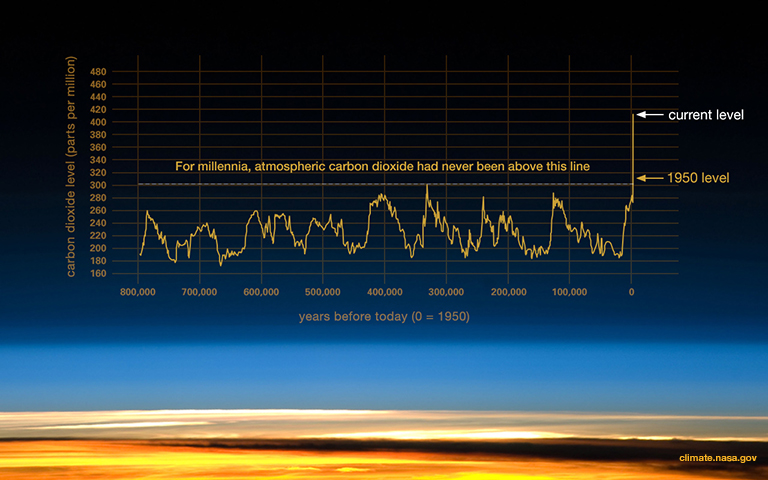
Source: NASA, National Oceanic and Atmospheric Administration, Luthi, D., et al., 2018
While global surface temperatures have already increased by about 1ºC since 1950, global temperature is projected to increase by another 2.5ºC in the next 40 years[5] and up to 4.5ºC by the end of the century, at the current pace of emissions[6]. This is poised to cause depletion of water resources, rising sea levels and severe pressure on our collective environmental system. Figure 2 demonstrates the historic global surface temperature compared to the 1951-1980 average since 1900.
Figure 2: Global Surface Temperature Compared to 1951-1980 Average
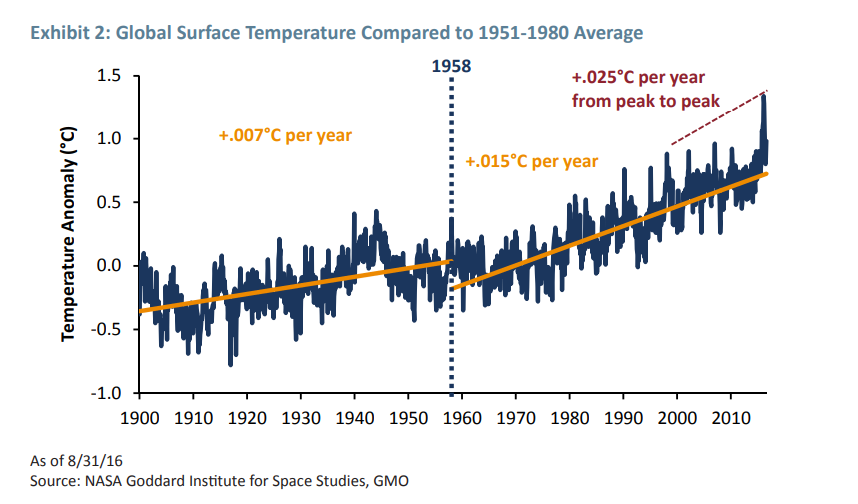
Source: NASA Goddard Institute for Space Studies, GMO Investments, 2016
Dropping Yields and Changing Fields
As each plant variety has a designated temperature range within which it can grow and reproduce, additional heat stress caused by global warming will stunt various crops’ ability to pollinate, retain moisture, and develop roots. Increasing temperatures, therefore, are expected to decrease the land area conducive to the production of high-calorie crops such as wheat, soy, and corn. A National Academy of Sciences study estimates a 5 to 15 percent decrease in grain crop production for each degree Celsius over current levels[7]. With temperatures currently rising, a rebalance of the agrarian equilibrium and a loss of biodiversity in oceans and forests is already taking place.
Overall crop yields are expected to begin their decline by 2030, and certain northern regions will be relied on to meet global nutritional needs[8]. Diseases, weeds, and insects, which thrive in warmer conditions, are expected to multiply and further restrain yield growth, while food nutrition is set to drop. Total yield decline is attributed in part to water scarcity and greater rainfall variability, the proliferation of pests, extreme heat events, and the reduction of multi-cropping in equatorial regions[9]. The International Food Policy Research Institute also recently published a study which found that plant nutrient availability is forecasted to significantly decline as a result of growing atmospheric CO2 levels[10]. Protein, iron, and zinc could each decline by between 15 and 20 percent in global availability over the next 30 years according to their model. In short, the world’s growing demographic will require more food to supply consumers with the same nutritional profile that we currently enjoy. Our collective ability to achieve this depends on an increase in crop yield per unit of farmland, in addition to an increase in global farmable land base.
Figure 3 depicts the forecasted change in farmland suitability to grow the 16 most common crops from averages in 1981–2010 to 2071–2100. Green areas exhibit an increase in suitability, while yellow and brown colored regions reveal where a decrease in land suitability occurs.
Figure 3: Change in agricultural suitability between 1981–2010 and 2071–2100.
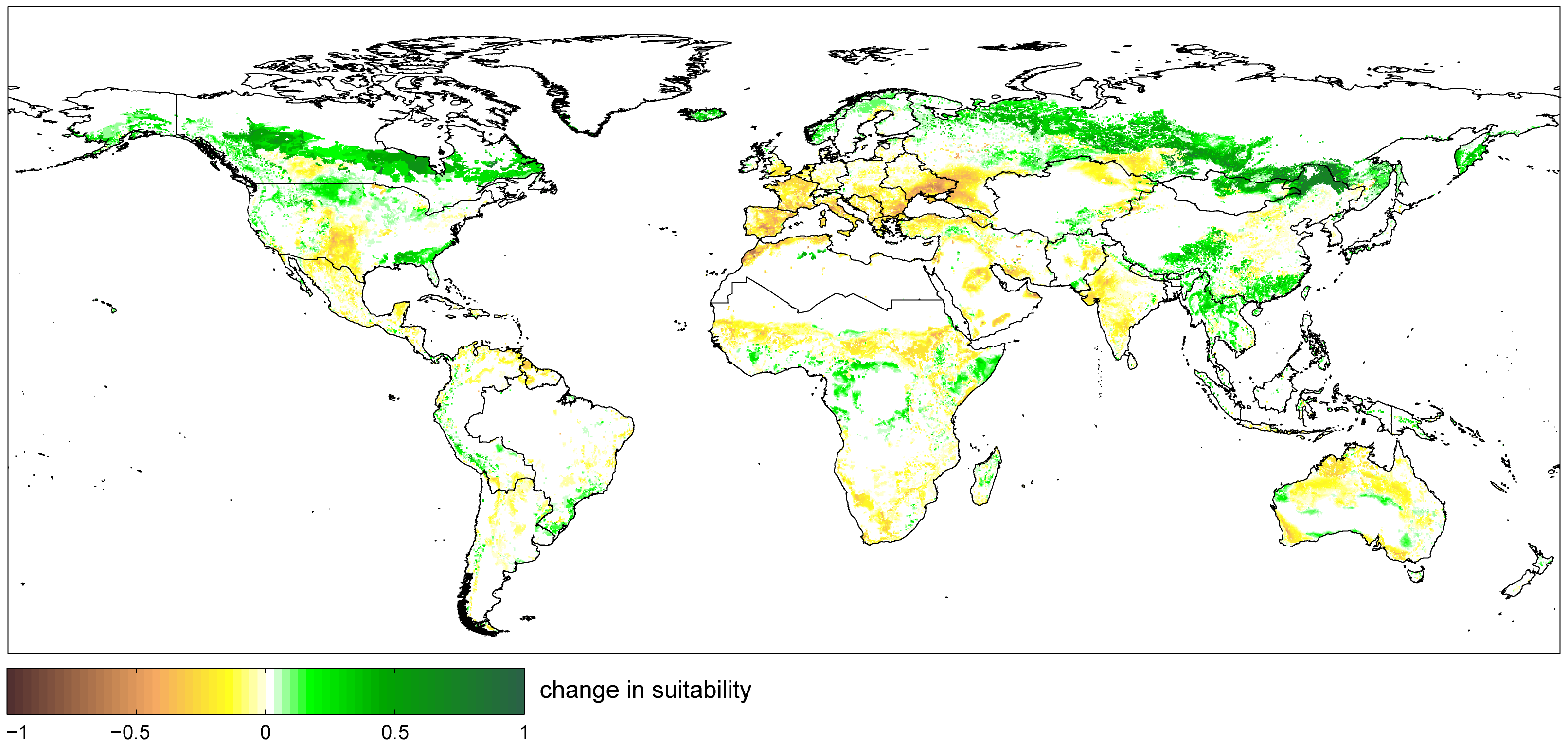
Source: Zabel, Putzenlechner & Mauser, 2014
The researchers who produced this map use an internationally recognized climate scenario model to determine the climatic and topographic changes that are expected by the late 21st century[11]. The findings from this study are clearly stated: higher latitude areas such as Canada, Norway, China, Russia, Mongolia, and parts of the United States are expected to grow in suitable land area by 2100. On the other hand, many warm-climate regions, which are accelerating in population growth and therefore nutritional needs, will face reduced land suitability.
Investing Where It’s Cool: The High Latitude Thesis
A longer growing season and additional heat units for crops such as wheat and corn will increase the area in northern regions that are conducive to temperate cereal cultivation. Figure 4 shows the boreal forest in green, along with the estimated movement of agricultural suitability boundaries in the northern hemisphere.
Figure 4: Northward shift of the agricultural climate zone under 21st-century global climate change King et al., 2018
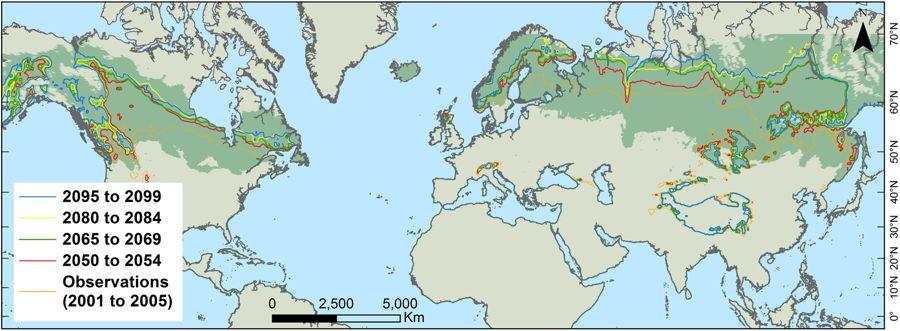
By 2099, about 76 percent of the area shown in green above is expected to reach crop feasible growing conditions compared to the current 32 percent[12]. For long-term investors with investment horizons of over 20 years, boreal regions such as the Clay Belt in Ontario and the Northern Prairies of Alberta are forecasted to become viable for large-scale grain and pulse production as temperatures increase. In these regions, the sparse populations and significant levels of capital needed to prepare the land for production have kept asset prices reasonably low. With the correct local knowledge and capital flows, tens of million acres in Canada and Russia that were previously untouched could emerge as the final frontier of scalable farmland use.
The high latitude investment thesis is not only underpinned by an increase in suitable land, but also an expected increase in crop yields. Figure 5 demonstrates the projected change in yields by sub-region between 2010 and 2050 considering a 3ºC increase in temperature from pre-industrial levels.
Figure 5: Projected Impacts on Crop Yields in a 3°C Warmer World
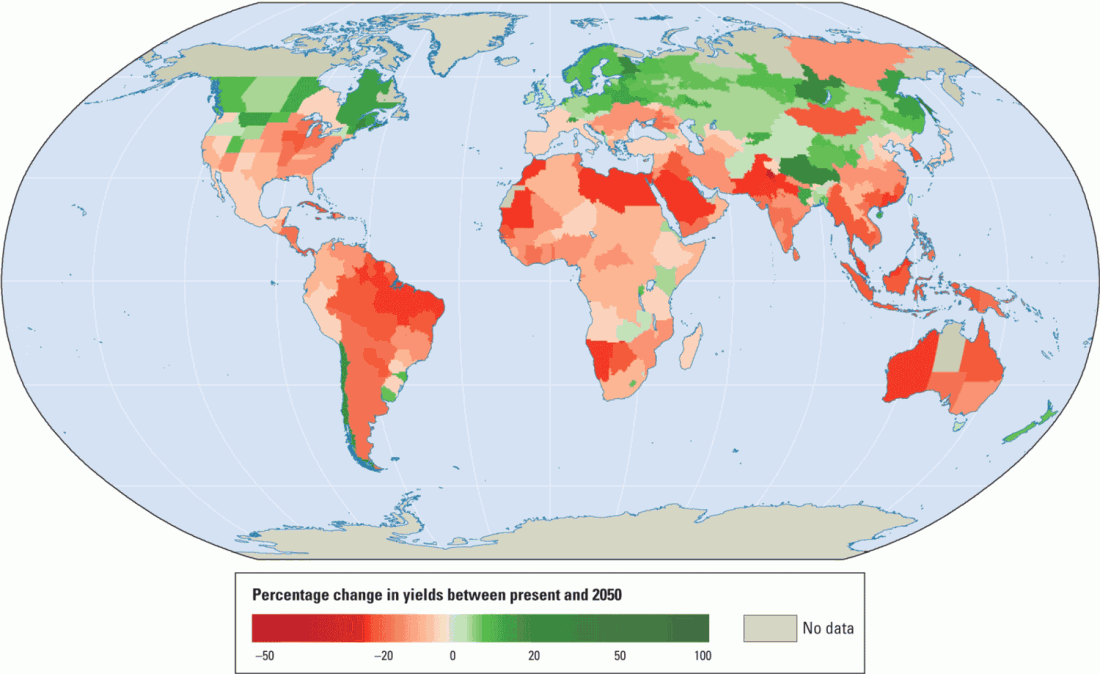
Source: World Resource Institute, The World Bank, 2010
The high-latitude investment thesis calls to immediate question the fact that many forested areas, which act as carbon sinks, would need to be converted to scalable crop production. It is then crucial for investors and policymakers to consider alternatives for preserving global ecosystem services, perhaps by investing in carbon offset programs or tree re-planting projects. With the knowledge and technology now available, investors are also urged to promote and implement production techniques that preserve and enhance affected ecosystem services. Evidence indicates that investment in regenerative agricultural practices, sustainable intensification, and maintaining soils with high levels of organic matter may mitigate some externalities of a warming planet[13]. Investment in foundational infrastructure strategies such as community development, transportation, green energy, and processing facilities could create opportunities for investors to diversify cash flows while integrating synergies with their farmland investments. A portfolio such as this would be a sustainable step forward to providing the world with the food it needs.
Continue Reading:
Part V – A Shift in the Air: Weather Volatility, Environmental Disasters, and Their Implications for Agriculture
About the Author
 Jeremy Stroud is an agricultural investment analyst with Bonnefield based in Toronto, Canada. With a background in international food business, he offers insights on global agri-food and water investments, value chain analysis, and economic systems. He has volunteered and worked with a spectrum of primary and vertically integrated agricultural groups in North and South America, Europe, and Africa.
Jeremy Stroud is an agricultural investment analyst with Bonnefield based in Toronto, Canada. With a background in international food business, he offers insights on global agri-food and water investments, value chain analysis, and economic systems. He has volunteered and worked with a spectrum of primary and vertically integrated agricultural groups in North and South America, Europe, and Africa.
[1] National Oceanic and Atmospheric Administration (NOAA), 2019
[2] Yale School of Forestry and Environmental Studies, 2019
[3] NASA, Climate Services, 2018
[4] California Agriculture, 2018
[5] Jeremy Grantham: The Race of Our Lives, Revisited, 2018
[6] Intergovernmental Panel on Climate Change, 2018
[7] National Academy of Sciences, 2011
[8] Intergovernmental Panel on Climate Change, 2018
[9] Zabel, Putzenlechner & Mauser, 2014
[10] International Food Policy Research Institute, 2019
[11] Zabel, Putzenlechner & Mauser, 2014
[12] King et al., 2018
[13] Climate smart or regenerative agriculture? Defining climate policies based on soil health, 2018

Let GAI News inform your engagement in the agriculture sector.
GAI News provides crucial and timely news and insight to help you stay ahead of critical agricultural trends through free delivery of two weekly newsletters, Ag Investing Weekly and AgTech Intel.




